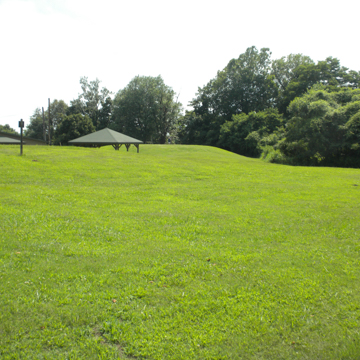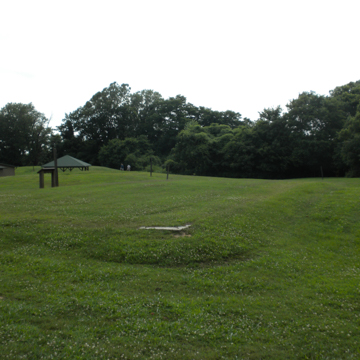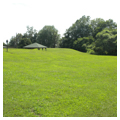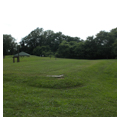Native Americans of the Mississippian culture settled on a rise next to the confluence of the Ohio and Mississippi rivers at Wickliffe, Kentucky, circa 1100 and stayed until circa 1350. Remains of four platform mounds and one funerary mound that were first excavated in the 1930s continue to provide information about the lives of pre-contact Native Americans.
Excavations at Wickliffe reveal that the Mississippians were farmers who grew corn and squash, hunted in the forests, and fished in the river; they used stone, shell, and bone tools, and crafted pottery from shell-tempered clay decorated with elaborate designs and decorations. Wickliffe was part of a vast trade network up and down the Mississippi River. The eight- to fifteen-foot-high platform mounds at Wickliffe echo the massive pyramidal platform mounds found at the largest of the Mississippian cities, Cahokia, in present-day Illinois.
The small town established during the Early Wickliffe period (1100–1175) was centered on a plaza that was located where the parking lot is now. According to the archaeological remains, circa 1175 the villagers began to build a platform mound, Mound B, as the base for the chief’s house. Atop the abbreviated pyramidal form of Mound B are the raised hearth and postholes for poles that held wattle-and-daub siding for the residence.
While the Mississippian houses were small by modern standards, 10 by 13 feet on average, they were well crafted and vibrantly painted. Wall trenches were dug first and dirt was filled back in after the posts were put in place; the walls themselves were made by daubing clay and straw over basket-like wattles. Recovered pieces of daub suggest that the houses were painted either red with white decorations or white with red decorations. The floors, too, were decorated. Roofs were made of thatch, which actually expands when wet, thereby providing waterproof covering for the inhabitants. Raised earthen hearths provided heat in the winter months. Built-in benches were a common component to Mississippian houses, while wooden seats were apparently reserved for important personages.
Mound A is the largest of the mounds and was built in six stages in the Middle Wickliffe Period between circa 1175 and 1250. Archaeologists believe that the structure atop the truncated polygonal mound was the largest and most important ceremonial house.
The remains of a well-preserved fired clay floor were discovered in 1989 just to the north of the chief’s house. Preserved on the floor was a painting of a Sun Circle (a cross within a circle), which is a commonly used symbol in Mississippian and Native American art that incorporates the four directions, the circle of the earth, and the sacred fire.
Burial Mound C was created circa 1250 and may actually have originally been three mounds. Some 50 years after its creation, Mound C began to be used as a burial site for children and adult Mississippians, while infants were buried in or near dwellings.
To the east of the plaza is Mound D, an elongated oval mound that formed the residential quarter of the village. Mound D was excavated by Fain King in the 1930s. King built the “Lifeways Building” over a large portion of Mound D, which he cleared of all but the earliest living layer dating to circa 1100–1200. Here, visitors can clearly see the postholes of the irregular rectangular walls of the Mississippian houses as well as the postholes of the wooden posts that supported cane or reed matted benches and raised earthen hearths. Also visible are the small rectangular mounds on which infants were buried.
Although Wickliffe continued to grow in the late Wickliffe Period (1250–1350), the villagers seem not to have constructed any new platform mounds. For unknown reasons, Wickliffe was abandoned circa 1350.
Ceded to the United States by the Chickasaw Peoples as part of the Jackson Purchase of 1818, Wickliffe Mounds was first recorded in 1888 by surveyor Robert Loughridge. After road construction in 1930 cut a channel through the site that revealed Native American artifacts, local lumberman and amateur archaeologist Fain King purchased the land from the Wisconsin Chair Company and began to excavate. King and his wife, Blanche Busey King, opened the “Ancient Buried City” as a tourist attraction. They eventually donated it to the Western Baptist Hospital, which, in turn, donated the site to Murray State University in 1984. Archaeologist Kit Wesler introduced modern methods and ethical standards to the newly reorganized Wickliffe Mounds Research Center, which have been maintained since the transfer of the site to the Commonwealth of Kentucky. Wesler, for instance, worked with the Chickasaw Peoples to properly reinter the human skeletal remains that King had put on display in the 1930s.
Wickliffe Mounds is now a State Historic Site, is designated as a Kentucky Archaeological Landmark, and is listed on the National Register of Historic Places. It is operated by the Kentucky Department of Parks and is regularly open to the public.
References
Wesler, Kit W. Excavations at Wickliffe Mounds. Lexington, KY: University of Alabama Press, 2001.

















